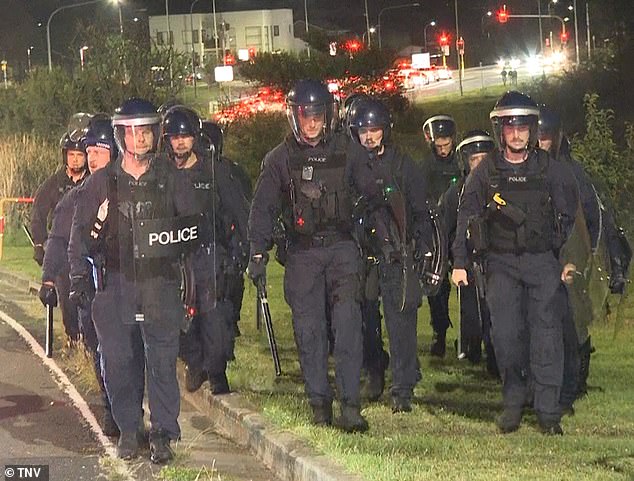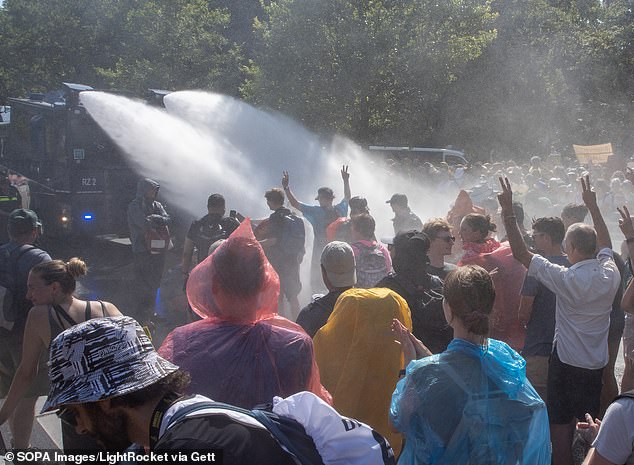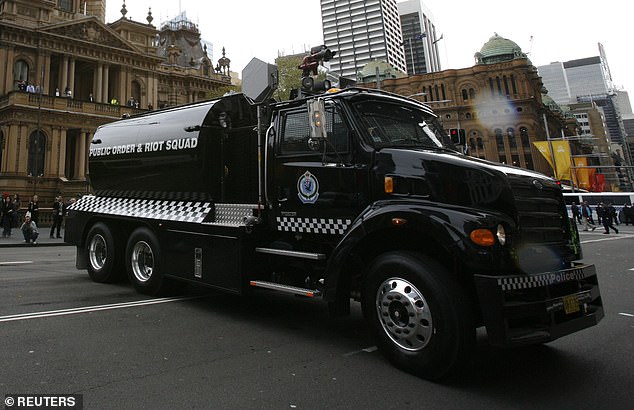Wakeley church stabbing: What happened to $700,000 police ‘superweapon’ for dealing with violent riots that YOU paid for – as 2,000 angry men cause chaos
EXCLUSIVE
Police gave away a $700,000 water cannon bought to counter violent public disturbances such as this week’s church riot in Wakeley, in Sydney’s western suburbs.
The water cannon was purchased in the aftermath of riots in Redfern in 2004 and Cronulla and Macquarie Fields in 2005, during a political era when there was tough talk about tackling crime.
The device was intended to be deployed in the most serious incidents of public disorder, but was given to Fire and Rescue NSW five years ago as it had never been used to quell a riot.
A gang of around 2,000 angry men were involved in a series of intense clashes with police in Wakeley, near Fairfield, on Monday evening.
Police gave away a $700,000 water cannon bought to counter violent public disturbances such as this week’s riot in Wakeley, in Sydney’s western suburbs. (Stock image of a water cannon)

An angry crowd of thousands were involved in a series of intense clashes with police in Wakeley, near Fairfield, on Monday evening. Officers were photographed at the scene
The riot was sparked by a 16-year-old boy allegedly stabbing Bishop Mar Mari Emmanuel during a live-streamed sermon at Christ The Good Shepherd Church.
The alleged knifeman was apprehended by members of the community before police arrived.
Parishioners took to the streets and surrounded the church from about 7 p.m. until after midnight.
Police deployed a helicopter and sent more than a hundred officers, including members of the Tactical Operations Unit and Public Order and Riot Squad.
Rioters threw stones at police and smashed the windows of several police cars. More than fifty officers were injured and several were taken to hospital.
Water cannons are used extensively for riot control in other parts of the world, including the US, South Africa, parts of Europe including Germany, and Asia.

NSW Police purchased a water cannon purchased in the aftermath of riots in Redfern in 2004 and Cronulla and Macquarie Fields in 2005. (Stock image of a water cannon)
The NSW government bought a US-built water cannon for police use 16 years ago, but the only time it was fired was at a media event.
The roof-mounted high-pressure cannon was mounted on a truck with a 12,000-liter tank and could shoot a stream of water more than 50 meters.
The vehicle was equipped with an airtight cabin to protect the occupants from smoke and gas and fitted with shatterproof, wire mesh reinforced ‘anti-bandit glass’.
A heavy push bar on the front of the black truck allowed it to clear barricades and other obstacles.
last month, NSW Liberal Upper House member Chris Rath sought an answer from the government on the device’s whereabouts.
“Do NSW Police still have water cannon?” Mr. Rath asked.
On April 11 he was told: ‘No. A water cannon previously owned by the NSW Police was donated to NSW Fire and Rescue in 2019.

The NSW government bought a US-built water cannon for police use 16 years ago, but the only time it was fired was at a media event
When the prospect of purchasing a water cannon was mooted after the Macquarie Fields riots, Police Commissioner Ken Moroney was not a fan of the idea.
“If we’ve reached the stage of bringing out water cannons… we’ve really lost track in that sense,” he said.
Labor Prime Minister Morris Iemma announced in March 2006, three months after the Cronulla race riots, that tenders would be invited for a water cannon to be used by the Public Order and Riot Squad.
“Water cannons have been used with great success to spread riots and civil disorder in Europe, the Middle East and Indonesia,” Iemma said at the time.
“We have never used one before in NSW, but recent events have shown that we need to be prepared for large-scale public disorder.”
The cannon was put on public display for the first time in Homebush Bay two weeks before the APEC (Asia-Pacific Economic Co-operation) summit in September 2007.
During that demonstration, the cannon knocked down 250-pound pylons in front of television cameras and newspaper photographers.
“Warning, warning, if you don’t disperse, the water cannon will be fired at you,” a voice said from inside the vehicle before the hose was pulled out.
‘Warning, warning, warning, the water cannon will be fired. Start, start, start.’
After that display, Mr Iemma dismissed the acquisition of the gun as a stunt and admitted it could cause “serious harm” if used on a crowd.
“I hope we never have to use such a device,” he said.
“But if the situation arises, if there are people who take the law into their own hands with riotous behavior on the streets, then this is a good weapon to restore order and control.”
Public Order and Riot Squad commander Chief Inspector Steve Cullen said he had stood in front of the gun to experience its power for himself and was not injured.
“In my opinion, it is a suitable device – and it looks intimidating and it should be, because it is one of the tactical options that we need to bring to APEC,” he told reporters.
An agreement was reached between the NSW Police Association and the government that the gun would never be pointed at strikers during industrial protests.
Daily Mail Australia understands police have never considered the device suitable for responding to riots.
By 2011, the gun had still not been used, but Liberal Police Minister Mike Gallacher said the force would not discharge it.
“This administration will preserve these resources because, now that they have been purchased, it makes economic sense to have them available if and when they are needed,” he said.
At the time, the device cost $3,000 per year to maintain and depreciated at 10 percent annually.
Greens MP David Shoebridge had said the police budget would be better spent on training rather than on “a few big toys that are barely taken out of the packaging”.
A spokeswoman for Fire and Rescue NSW said the donated tanker was based in the state’s west and had been “used on many occasions to assist with bushfires”.
“The resource was used during the 2019/2020 Black Summer campaign and played an important role in helping protect the Jenolan Caves,” she told Daily Mail Australia.
“When fire threatened one of the state’s most beloved tourist attractions, the bulk water tanker helped maintain water supplies to the area.”
The tanker was used in the state’s central west in 2023 to help fight bushfires around Gulgong, Ulan, Cope and Cooks Gap, and as a water supply vehicle during drought.
